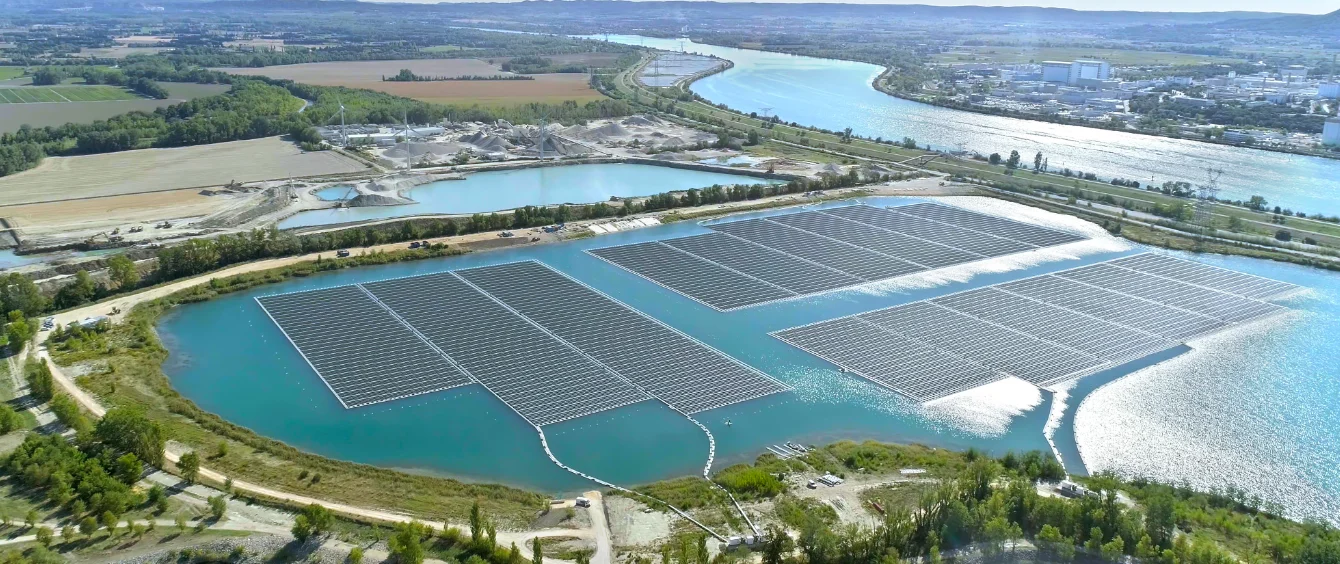Search
Frequent requests
‘Floatovoltaics,’ is the new term coined by the sector for ‘floating photovoltaics,’ or offshore solar farms. For several years, this technology, which enables solar modules to be installed on bodies of water, has been experiencing a veritable boom. According to World Bank, global installed capacity has risen from some ten megawatts (MW) in 2014 to far over one gigawatt (GW) today. Floating solar has thus evolved from niche application to a technology suitable for commercial use. It is set to gain significance going forward, with many new projects to come in this and the next few years.
The concept offers several advantages: Whereas large-scale ground-mounted PV systems occupy a lot of space, which is a scarce commodity especially in densely populated areas with great demand for energy, floating systems can simply be set up on floats on lakes or in coastal waters. Moreover, modules mounted on floats and moored to buoys promise higher yields. One of the reasons is that water acts as a natural coolant for the cells, enabling them to operate efficiently even at high external temperatures. These and further benefits are causing increasing numbers of operators to opt for this technology – and build ever-larger arrays. en:former has put together an image gallery to present some of the most powerful of these systems.
Bildinformationen:
The world's largest offshore solar farms have peak capacities exceeding 100 MW and call China their home. One such plant was installed in November 2017 on a lake in Guqiao in the Province of Anhui, which is located in the eastern part of the country. According to manufacturer Sungrow Power Supply Co., boasting a capacity of 150 MW, Huainan Solarpark currently sits atop the world rankings. Harnessing the output from 645,000 PV modules, the farm supplanted the previous frontrunner: a 40 MW solar array by Sungrow (photo), which is running on the premises of a former coal mine on a lake in the same region.
© Imaginechina Limited, Alamy Stock Foto
Bildinformationen:
Based on information from the operator, renewables provider BayWa r.e., the world's largest offshore solar farm outside China is situated in the vicinity of Zwolle in the Netherlands. Within the space of just eight weeks in early 2020, the company installed 73,000 PV modules, 13 floating transformers and 338 inverters on a dredging lake. The PV system is rated at 27.4 megawatts. In addition, the company completed the nearby 14.5 MW Sekdoorn project, the 8.4 MW project in Tynaarlo, and the 2.1 MW plant in Weperpolder.
© BayWa r.e.
Bildinformationen:
Singapore's first floating PV farm immediately found itself in the global premier league: Sunseap Group, Singapore's leading solar energy provider, announced the completion of the biggest ocean floating PV project to date in March 2021. A total of 13,312 panels, 40 inverters and over 30,000 floats were installed on the Straight of Johor on a surface area equal to five soccer fields. According to Sunseap, the system has an aggregate capacity of five MW. The farm is connected to the national grid via a submarine cable. Furthermore, it features a climate-controlled second deck, which serves as a visitor centre and vista point.
© Sunseap Group
Bildinformationen:
Japanese Kyocera Group and financial service provider Century Tokyo Leasing Corporation founded a joint venture in 2014 for the purpose of building the world's largest floating PV plant. By 2016, the partner companies had installed some 50,000 Kyocera solar modules on 180,000 square metres covering the Yamakura dammed water reservoir. Boasting an output of 13.7 MW, the solar farm remains one of the most powerful of its kind to date.
© shutterstock.com, dreamnikon
Bildinformationen:
Since 2019, Erdgas Südwest has been operating what the company considers to be the largest offshore solar farm in Germany thus far on the roughly 43 hectare excavated Lake Maiwald in Renchen near Achern (District of Ortenau). The 2,300 floating PV modules have a combined peak production of 750 kilowatt hours, a large portion of which is supplied to the gravel works that excavate raw minerals from the manmade lake and processes them on site.
© Jörg Wilhelm / Ossola GmbH
Bildinformationen:
October of 2019 saw the commissioning of Europe's then most powerful offshore solar farm, located in the south of France. Situated in Piolenc in the region of Provence-Alpes-Côte d’Azur, 47,000 O’MEGA 1 PV modules rest on a lake in an old stone quarry. The farm was built by Bouygues Energies Services. Module manufacturer Akuo Energy has opted for crowdfunding as an element of project financing. This gave the region's residents the opportunity to use an online platform to invest in the solar farm. The municipality also covered a share of the costs. Spanning 17 hectares, the system has a capacity of 17 MW, enough to supply electricity to 4,373 homes.
© Akuo Energy
Bildinformationen:
German energy utility RWE is also placing its chips on floating PV systems. Construction is scheduled to commence in August 2021, at which time 13,400 PV modules will be installed in the vicinity of Amercentrale Power Station in Geertruidenberg in the Dutch Province of Noord-Brabant. The solar farm will have a maximum capacity of 6.1 MW and is slated to go online by the end of 2021.
© shutterstock.com, Ajintai
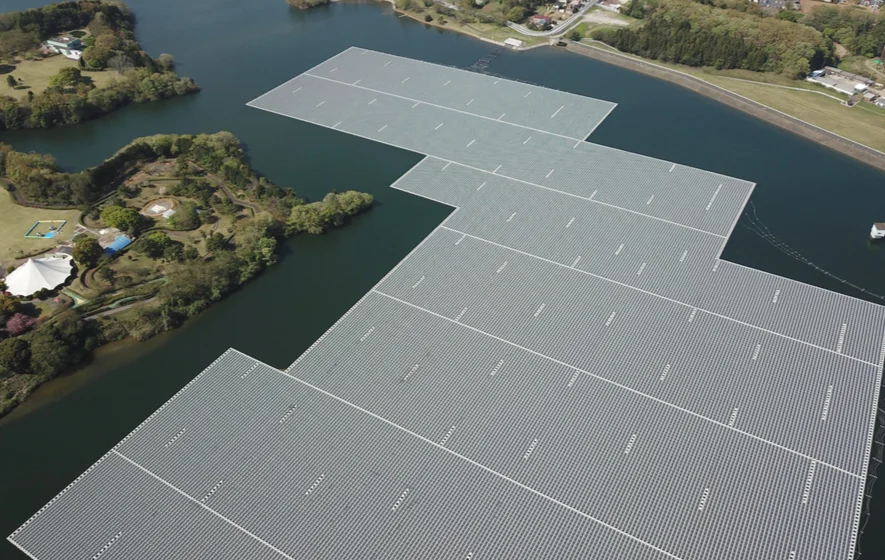
Japanese Kyocera Group and financial service provider Century Tokyo Leasing Corporation founded a joint venture in 2014 for the purpose of building the world's largest floating PV plant. By 2016, the partner companies had installed some 50,000 Kyocera solar modules on 180,000 square metres covering the Yamakura dammed water reservoir. Boasting an output of 13.7 MW, the solar farm remains one of the most powerful of its kind to date.
© shutterstock.com, dreamnikon
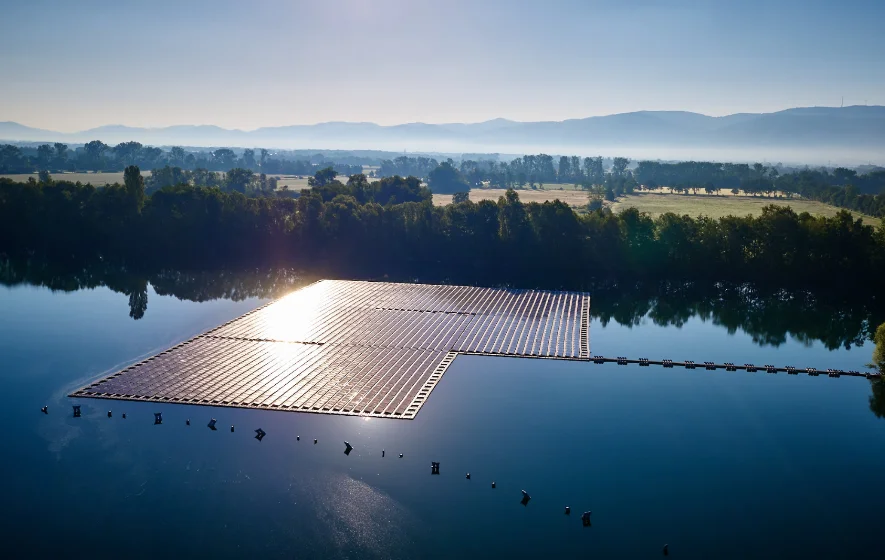
Since 2019, Erdgas Südwest has been operating what the company considers to be the largest offshore solar farm in Germany thus far on the roughly 43 hectare excavated Lake Maiwald in Renchen near Achern (District of Ortenau). The 2,300 floating PV modules have a combined peak production of 750 kilowatt hours, a large portion of which is supplied to the gravel works that excavate raw minerals from the manmade lake and processes them on site.
© Jörg Wilhelm / Ossola GmbH
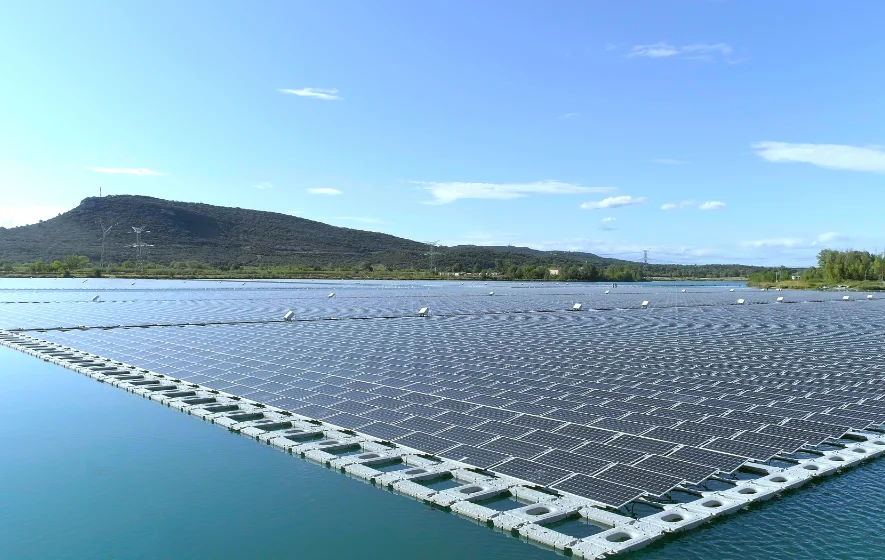
October of 2019 saw the commissioning of Europe's then most powerful offshore solar farm, located in the south of France. Situated in Piolenc in the region of Provence-Alpes-Côte d’Azur, 47,000 O’MEGA 1 PV modules rest on a lake in an old stone quarry. The farm was built by Bouygues Energies Services. Module manufacturer Akuo Energy has opted for crowdfunding as an element of project financing. This gave the region's residents the opportunity to use an online platform to invest in the solar farm. The municipality also covered a share of the costs. Spanning 17 hectares, the system has a capacity of 17 MW, enough to supply electricity to 4,373 homes.
© Akuo Energy
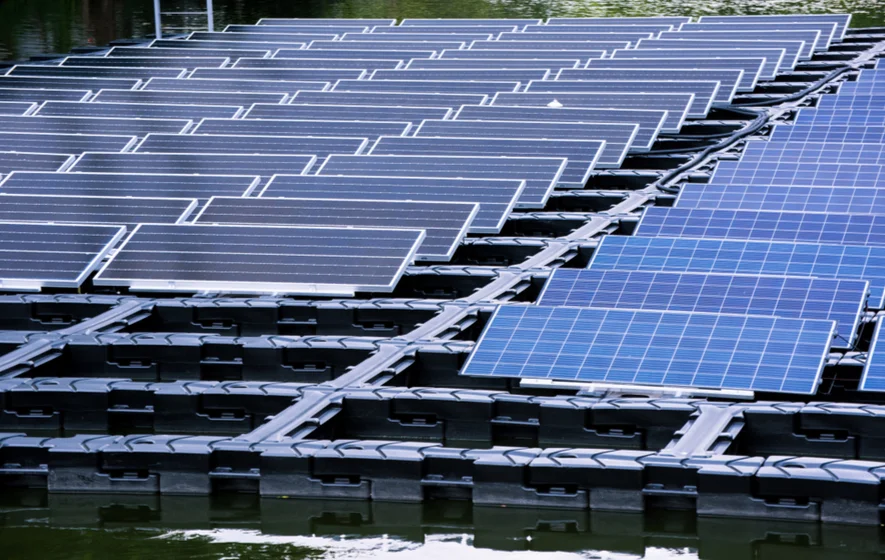
German energy utility RWE is also placing its chips on floating PV systems. Construction is scheduled to commence in August 2021, at which time 13,400 PV modules will be installed in the vicinity of Amercentrale Power Station in Geertruidenberg in the Dutch Province of Noord-Brabant. The solar farm will have a maximum capacity of 6.1 MW and is slated to go online by the end of 2021.
© shutterstock.com, Ajintai
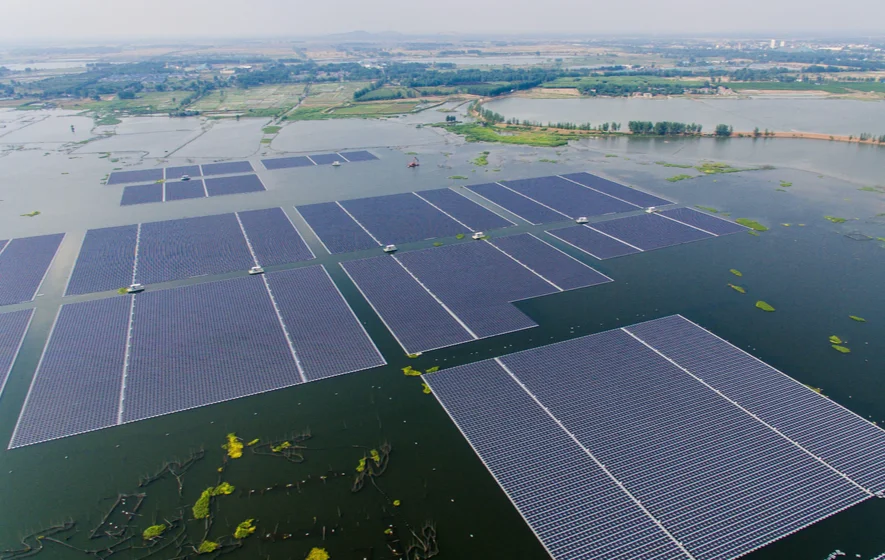
The world's largest offshore solar farms have peak capacities exceeding 100 MW and call China their home. One such plant was installed in November 2017 on a lake in Guqiao in the Province of Anhui, which is located in the eastern part of the country. According to manufacturer Sungrow Power Supply Co., boasting a capacity of 150 MW, Huainan Solarpark currently sits atop the world rankings. Harnessing the output from 645,000 PV modules, the farm supplanted the previous frontrunner: a 40 MW solar array by Sungrow (photo), which is running on the premises of a former coal mine on a lake in the same region.
© Imaginechina Limited, Alamy Stock Foto
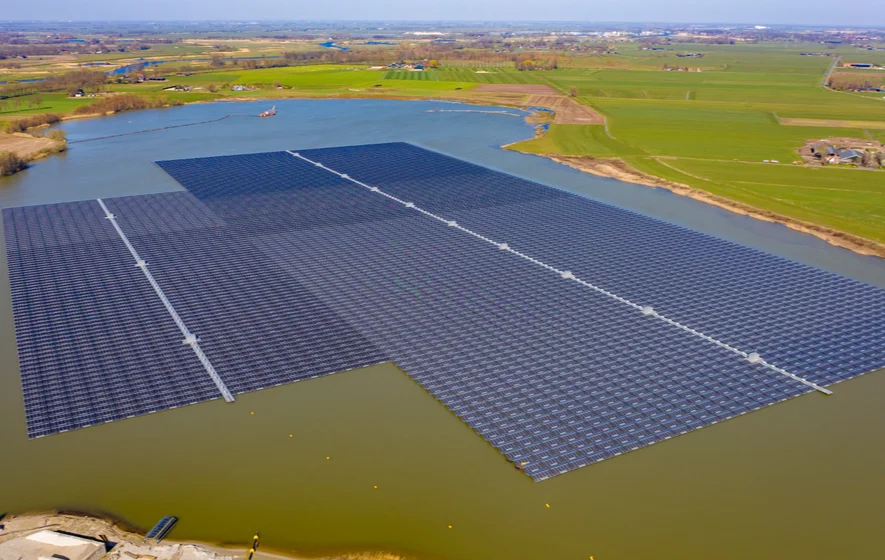
Based on information from the operator, renewables provider BayWa r.e., the world's largest offshore solar farm outside China is situated in the vicinity of Zwolle in the Netherlands. Within the space of just eight weeks in early 2020, the company installed 73,000 PV modules, 13 floating transformers and 338 inverters on a dredging lake. The PV system is rated at 27.4 megawatts. In addition, the company completed the nearby 14.5 MW Sekdoorn project, the 8.4 MW project in Tynaarlo, and the 2.1 MW plant in Weperpolder.
© BayWa r.e.
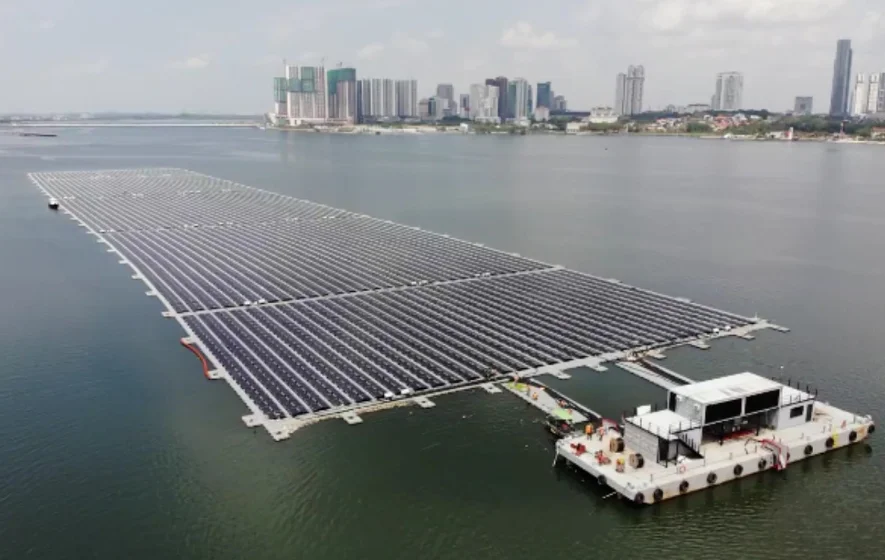
Singapore's first floating PV farm immediately found itself in the global premier league: Sunseap Group, Singapore's leading solar energy provider, announced the completion of the biggest ocean floating PV project to date in March 2021. A total of 13,312 panels, 40 inverters and over 30,000 floats were installed on the Straight of Johor on a surface area equal to five soccer fields. According to Sunseap, the system has an aggregate capacity of five MW. The farm is connected to the national grid via a submarine cable. Furthermore, it features a climate-controlled second deck, which serves as a visitor centre and vista point.
© Sunseap Group

Japanese Kyocera Group and financial service provider Century Tokyo Leasing Corporation founded a joint venture in 2014 for the purpose of building the world's largest floating PV plant. By 2016, the partner companies had installed some 50,000 Kyocera solar modules on 180,000 square metres covering the Yamakura dammed water reservoir. Boasting an output of 13.7 MW, the solar farm remains one of the most powerful of its kind to date.
© shutterstock.com, dreamnikon

Since 2019, Erdgas Südwest has been operating what the company considers to be the largest offshore solar farm in Germany thus far on the roughly 43 hectare excavated Lake Maiwald in Renchen near Achern (District of Ortenau). The 2,300 floating PV modules have a combined peak production of 750 kilowatt hours, a large portion of which is supplied to the gravel works that excavate raw minerals from the manmade lake and processes them on site.
© Jörg Wilhelm / Ossola GmbH

October of 2019 saw the commissioning of Europe's then most powerful offshore solar farm, located in the south of France. Situated in Piolenc in the region of Provence-Alpes-Côte d’Azur, 47,000 O’MEGA 1 PV modules rest on a lake in an old stone quarry. The farm was built by Bouygues Energies Services. Module manufacturer Akuo Energy has opted for crowdfunding as an element of project financing. This gave the region's residents the opportunity to use an online platform to invest in the solar farm. The municipality also covered a share of the costs. Spanning 17 hectares, the system has a capacity of 17 MW, enough to supply electricity to 4,373 homes.
© Akuo Energy

German energy utility RWE is also placing its chips on floating PV systems. Construction is scheduled to commence in August 2021, at which time 13,400 PV modules will be installed in the vicinity of Amercentrale Power Station in Geertruidenberg in the Dutch Province of Noord-Brabant. The solar farm will have a maximum capacity of 6.1 MW and is slated to go online by the end of 2021.
© shutterstock.com, Ajintai

The world's largest offshore solar farms have peak capacities exceeding 100 MW and call China their home. One such plant was installed in November 2017 on a lake in Guqiao in the Province of Anhui, which is located in the eastern part of the country. According to manufacturer Sungrow Power Supply Co., boasting a capacity of 150 MW, Huainan Solarpark currently sits atop the world rankings. Harnessing the output from 645,000 PV modules, the farm supplanted the previous frontrunner: a 40 MW solar array by Sungrow (photo), which is running on the premises of a former coal mine on a lake in the same region.
© Imaginechina Limited, Alamy Stock Foto

Based on information from the operator, renewables provider BayWa r.e., the world's largest offshore solar farm outside China is situated in the vicinity of Zwolle in the Netherlands. Within the space of just eight weeks in early 2020, the company installed 73,000 PV modules, 13 floating transformers and 338 inverters on a dredging lake. The PV system is rated at 27.4 megawatts. In addition, the company completed the nearby 14.5 MW Sekdoorn project, the 8.4 MW project in Tynaarlo, and the 2.1 MW plant in Weperpolder.
© BayWa r.e.

Singapore's first floating PV farm immediately found itself in the global premier league: Sunseap Group, Singapore's leading solar energy provider, announced the completion of the biggest ocean floating PV project to date in March 2021. A total of 13,312 panels, 40 inverters and over 30,000 floats were installed on the Straight of Johor on a surface area equal to five soccer fields. According to Sunseap, the system has an aggregate capacity of five MW. The farm is connected to the national grid via a submarine cable. Furthermore, it features a climate-controlled second deck, which serves as a visitor centre and vista point.
© Sunseap Group

Japanese Kyocera Group and financial service provider Century Tokyo Leasing Corporation founded a joint venture in 2014 for the purpose of building the world's largest floating PV plant. By 2016, the partner companies had installed some 50,000 Kyocera solar modules on 180,000 square metres covering the Yamakura dammed water reservoir. Boasting an output of 13.7 MW, the solar farm remains one of the most powerful of its kind to date.
© shutterstock.com, dreamnikon
